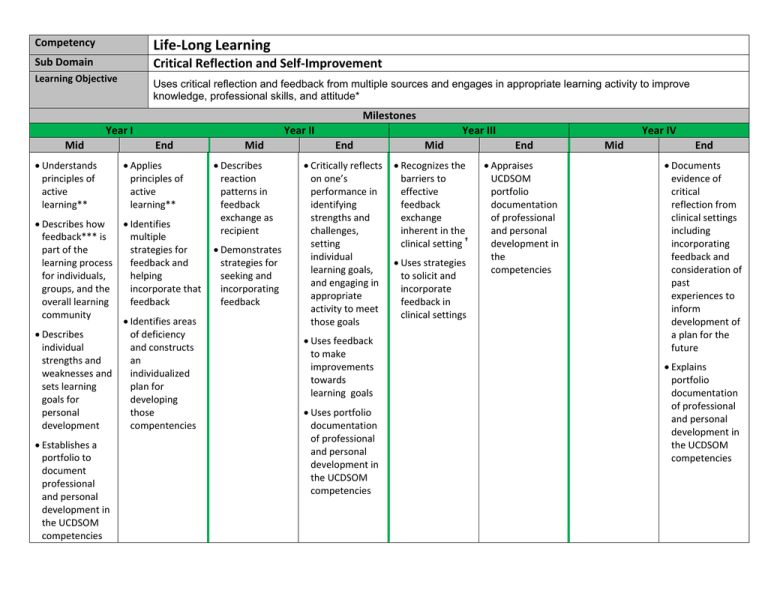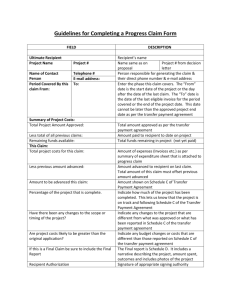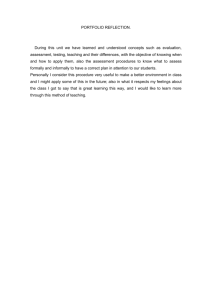Life-Long Learning Critical Reflection and Self-Improvement Competency Sub Domain
advertisement

Life-Long Learning Competency Critical Reflection and Self-Improvement Sub Domain Learning Objective Mid Uses critical reflection and feedback from multiple sources and engages in appropriate learning activity to improve knowledge, professional skills, and attitude* Year I End • Understands principles of active learning** • Applies principles of active learning** • Describes how feedback*** is part of the learning process for individuals, groups, and the overall learning community • Identifies multiple strategies for feedback and helping incorporate that feedback • Describes individual strengths and weaknesses and sets learning goals for personal development • Establishes a portfolio to document professional and personal development in the UCDSOM competencies • Identifies areas of deficiency and constructs an individualized plan for developing those compentencies Mid • Describes reaction patterns in feedback exchange as recipient • Demonstrates strategies for seeking and incorporating feedback Year II Milestones End • Critically reflects on one’s performance in identifying strengths and challenges, setting individual learning goals, and engaging in appropriate activity to meet those goals • Uses feedback to make improvements towards learning goals • Uses portfolio documentation of professional and personal development in the UCDSOM competencies Mid Year III • Recognizes the barriers to effective feedback exchange inherent in the clinical setting † • Uses strategies to solicit and incorporate feedback in clinical settings End • Appraises UCDSOM portfolio documentation of professional and personal development in the competencies Mid Year IV End • Documents evidence of critical reflection from clinical settings including incorporating feedback and consideration of past experiences to inform development of a plan for the future • Explains portfolio documentation of professional and personal development in the UCDSOM competencies Appendix *Applies Practice-Based Learning Improvement principles to the improvement of knowledge, professional skills, and attitude. **Active Learning: • Self-assessment of learning needs • Independent identification, analysis, and synthesis of information relevant to learning needs • Appraisal of the credibility of information sources • Sharing information with peers and supervisors *** Feedback Definition: Information provided to help with making adjustments/corrections/improvements/refinement in order to achieve the learning objectives of the recipient (i.e., student, peers, faculty, staff). Not just evaluation. Elements of Effective Feedback : • Specific • Helps learner progress towards their learning objectives • Mutual respect • With the premise that there is the capacity for improvement • Reciprocal dialogue • Timely • Relevant and applicable • Learning objective(s) are mutually agreed upon by recipient and provider • Collaborative professional relationships are necessary for and require effective feedback • To give and receive feedback, while useful, may be inherently uncomfortable Role of Recipient and Providers of Feedback: Recipients are able to: • discuss their learning goals • contribute to safe learning environment • recognize that effective feedback is usually uncomfortable • be open to potential for improvement through feedback • critically appraise the feedback • constructively discuss feedback received • mutually arrive at a meaningful assessment and plan of action towards learning objective Providers are able to: • discuss learning goals • contribute to safe learning environment • • • • • • † have given thoughtful and diligent assessment of the learner’s assets and needs prior to the exchange recognize that effective feedback is usually uncomfortable assess recipient’s level of readiness for feedback identify and address barriers to receiving feedback develop a safe space for discussion and critical appraisal of the feedback given mutually arrive at a meaningful assessment and plan of action towards learning objective Examples of barriers to effective feedback exchange: multiple sources, varying levels of reliability, health care hierarchy, conflicts of interest

![Smith College Northampton, Massachusetts 01063 [Click here and type phone number]](http://s2.studylib.net/store/data/012883666_1-a1fc8c92a34bfcfd42acd92bed2a3224-300x300.png)
